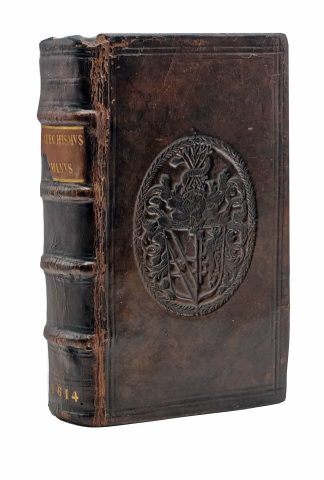CATECHISMUS ex decreto Sacrosancti Concilii Tridentini.
RECUSANT ARMORIAL BINDING
CATECHISMUS ex decreto Sacrosancti Concilii Tridentini.
Lyon, apud Haeredes Gulielmi Rouillij, 1614.£2,250.00
8vo. pp. [32], 704, [38], lacking last, as usual, doubtless blank. Roman letter, Italic sidenotes. Title in red and black, woodcut vignette of Sts Peter and Paul, decorated initials and ornaments. Ffep slightly adhering to blank gutter of title, with short clean tear, creased and softened, faint water stain to upper outer corner of early and final gatherings, lower outer corner of 2Z1 torn off affecting signature. A good copy in contemporary polished calf, double blind ruled, blind-stamped centrepiece with impaled arms of Geoffrey Elwes (1541-1616) surrounded by wreath to covers, partly painted gules to lower, raised bands, compartments double blind ruled, remains of label, a.e.r., C19 eps, joints rubbed. Armorial bookplate of Sir John Williams of Bodlewyddan (1794-1859) to front pastedown.
This unusual armorial binding was produced c.1615, and bears the impaled arms of Geoffrey Elwes (or Yelvis or Helwys, c.1551-1616), from Askham, Yorkshire, later Woodford, Essex, and Elizabeth Gabbatt, from Shrewsbury, whom he married in London in 1570. We have not traced any other bindings bearing this this centrepiece. Geoffrey was Master of the Merchant-Taylors’ Company, Alderman and Sheriff of London. His nephew, Sir Gervase Elwes, was executed in 1615 for the murder of Sir Thomas Overbury in the Tower of London, where he was lieutenant. Geoffrey’s son, Sylvius or Silvester (1576-1638), was a famous Cambridge bibliophile, chaplain at Trinity College, Cambridge. Northern England and Essex hosted numerous recusants communities, including members of the Elwes and Gabbatt families. Considering the successful public careers of Geoffrey, his siblings and nephews, the family must have successfully concealed their Catholicism and attended some Anglican services.
This handsomely bound, scarce edition of the Tridentine ‘Catechism’ was an evidently cherished book in the family library, despite the risks. Supported by St Charles Borromeo and first published in 1566, it was an official manual for priests and the first such work providing an authorised, uniform interpretation of the Catholic faith. It was planned at the Council of Trent and approved by Pius V. It includes ‘lectiones’ for all religious feasts, the Apostles’ Creed (i.e., 13 statements of belief), formulae for the sacraments and the Ten Commandments, methods of prayer and an explanation of the ‘Oratio Dominica’ (Lord’s Prayer). For English Catholics, it was a source of inspiration for private devotion; it was only translated into English under James II.
No copies recorded in the US. Not in USTC. Book Owners Online .In stock





